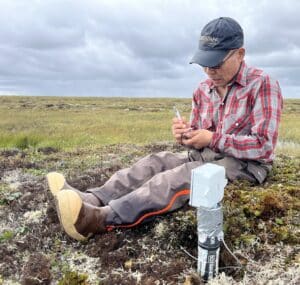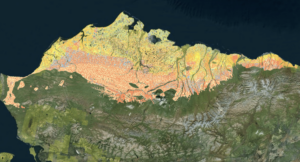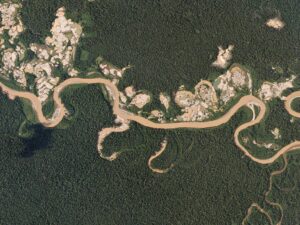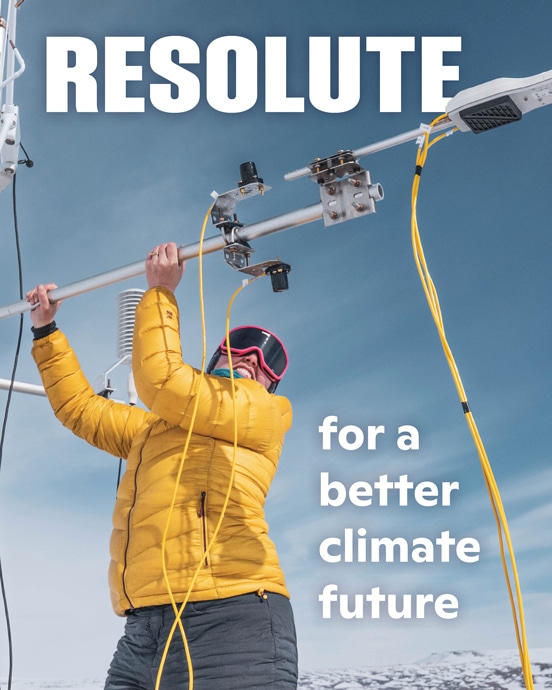Between land and water: Tribal relocation and resistance

Climate change is altering the land we live on, and Indigenous communities are on the frontline. In this episode, we bring you to Alaska, where rapid permafrost thaw is threatening the Native village of Nunapitchuk. Then, we head to Louisiana, where the Pointe-Au-Chien Indian Tribe is watching their land disappear underwater due to sea level rise. These threats are forcing these tribes to make the difficult decision: to stay and adapt, or to leave their ancestral home.
Read more or listen on Sea Change.
Woodwell Climate Conversations: Enduring Impact
Max Holmes, President and CEO of Woodwell Climate, and Dr. John Holdren, Former Chief Science and Technology Advisor to President Obama, on adapting with purpose and the lessons learned from political turbulence.
Learn more about our Climate Conversations series.
Climate futures: What’s ahead for our world beyond 1.5°C of warming?

Humanity stands at a critical juncture in the climate emergency: As countries worldwide prepare to submit their climate commitments for the next decade, scientists report mounting evidence that we are very close to breaching the 1.5° Celsius limit set by the Paris Agreement 10 years ago.
Beyond 1.5°C (2.7° Fahrenheit), we increasingly risk crossing climate tipping points, with dire consequences.
June 2025 collaborator highlight: Permafrost Discovery Gateway

The Permafrost Discovery Gateway (PDG) is an online data visualization platform hosted by the Arctic Data Center that provides openly accessible permafrost conditions across the Arctic region for researchers, educators, and the public. The PDG leverages satellite imagery and artificial intelligence (AI) to create maps of lake change, retrogressive thaw slumps, wildfire areas, ice-wedge polygons, coastal erosion, infrastructure, and surface water. To help communities, researchers, and policymakers navigate the changing landscape, the team aims to provide automated monthly monitoring of permafrost thaw during the snow-free season.
Read more on the Arctic Data Center website.
As the Arctic heats up three to four times faster than the rest of Earth, hotter temperatures have super-charged northern fires, causing them to burn more area, more frequently, and more intensely.
These fires have a range of harmful impacts on communities, ecosystems, and wildlife in the north. When it comes to carbon, they represent a unique now-and-future threat to global climate. That’s because much of the boreal forest, which circles the high northern latitudes, is underlain by carbon-rich frozen ground called permafrost. Stocked with carbon from dead animal and plant matter that’s accumulated over hundreds to thousands of years, permafrost functions as Earth’s “deep freezer,” keeping the planet cool by keeping carbon out of the atmosphere.
When permafrost thaws, microbes begin to access and break down the once-frozen carbon, releasing it to the atmosphere where it contributes to warming. Wildfires accelerate this process by burning off the organic soil layer that protects permafrost— opening the door on the freezer. And as temperatures in the north rise and boreal forests dry out and experience greater climate stress, the fires these forests evolved with have become more frequent and severe, with consequences for both permafrost and our climate.
Why are boreal forests important to climate?
The boreal forest, the largest forested biome on Earth, covers large stretches of North America, Europe, and Russia and stores 25% of the planet’s terrestrial carbon. Roughly 80% of this carbon is stored belowground in the form of soil organic matter and permafrost. So when the forest burns, the carbon released from the trees is just the tip of the iceberg. Eighty percent or more of carbon emissions from boreal fires in North America and in central Siberia come from belowground combustion of soil organic matter.
Boreal forests have been reliable safekeepers of this belowground carbon historically by providing an insulating soil organic layer that protects permafrost. But increasingly severe fires are changing that picture.
What happens to permafrost when the boreal burns?
Wildfires threaten this belowground carbon in boreal forests in multiple ways, both during and long after the fire itself.
As a fire burns, it combusts the carbon stored in trees and plants, releasing it into the atmosphere along with smoke and harmful pollutants. Intense fires also burn through duff and soil layers that carpet the forest floor.
Burning these insulating layers exposes the permafrost below to warmer temperatures for years after a fire. A recent synthesis study led by Postdoctoral Researcher Dr. Anna Talucci of Woodwell Climate found that in burned sites across the boreal and tundra regions, the depth of seasonally thawed ground increased for two decades after a fire.
That means that long after a fire is extinguished, permafrost is still thawing and releasing carbon in the form of carbon dioxide and methane. Where this ground is rich in ice, it can sink and collapse after a fire, causing ponding, erosion, and creating bogs and wetlands that release methane.
All of this carbon released to the atmosphere contributes to further warming, which in turn contributes to drying forests, hotter temperatures, and more lightning ignitions in the boreal forests. That’s because warming has boosted both lightning ignition efficiency, or the likelihood that lightning starts a fire, and the number of lightning strikes in the region.
Average yearly burned area across Alaska and Canada has roughly doubled since the 1960s. Emissions from Canada’s 2023 fire season exceeded total fossil fuel emissions from every other nation except the U.S., China, and India for that year. And the frequency of extreme wildfires across the circumpolar boreal region increased seven-fold from 2003 to 2023.
These trends, amplified by the permafrost-fire feedback, worsen both Arctic impacts and global emissions and could hamper our ability to meet agreed-on climate goals.
Gaps in boreal fire research
Wildfires in boreal forests are already weakening the region’s carbon storage capacity, signalling a crucial shift in the global climate system. Addressing critical gaps in our understanding of the fire-permafrost feedback will help prepare for such shifts and their local and global implications.
Research teams including Permafrost Pathways and collaborators are refining tools to predict what increasing fires mean for regional and global carbon emissions and climate targets. Such insights are needed to inform the Intergovernmental Panel on Climate Change’s (IPCC) inventory of global emissions, which does not yet include fire emissions or fire-caused permafrost thaw emissions. Efforts to better model and predict the complex interactions between permafrost and fire are also critical to informing adaptation and management responses.
The region’s vastness, as well as geopolitical conditions, presents challenges to collecting field data. Here, modeling can help scale the insights from what field data is available. And developing more accurate fire maps in Alaska and Siberia, where less burned area satellite data exists, could equip researchers and communities with better near-real-time information. Long-term monitoring efforts that study pre- and post-fire conditions, such as those led by Łı́ı́dlı̨ı̨ Kų́ę́ First Nation at the Scotty Creek Research Station, are providing critical insights about fire’s acute and long-term effects on permafrost.
What we can do: solutions that support resilience
The impacts from widespread severe northern wildfires transcend boundaries, affecting health and ways of life for communities living in the Arctic and around the globe.
But there are solutions at hand. Cultural burning, an important practice for many Arctic Indigenous communities, can help boreal forests build resilience by removing fuels with low-intensity seasonal fire. And collaborative management approaches that suppress fires in permafrost regions have been shown to be a cost-effective climate mitigation tool that has co-benefits for human health and the global climate.
But the most important solution to help keep the global wildfire-permafrost feedback loop in check is to reduce greenhouse gas emissions. Lowering overall emissions will slow rising temperatures in the north and give communities, boreal forests, and other ecosystems a better chance to recover and to adapt.
Gold mining causes long-lasting damage in the Amazon rainforest

A recent study has found that efforts to restore forests in the Peruvian Amazon after gold mining are failing – not only because of toxic soil, but because the land has lost its water.
A popular method called suction mining reshapes the landscape so dramatically that it strips away moisture and traps heat, creating extreme conditions that young trees cannot survive.
The study was led by Abra Atwood of the Woodwell Climate Research Center, alongside collaborators from Columbia University, Arizona State University, and Peru’s Universidad Nacional de San Antonio Abad del Cusco.




